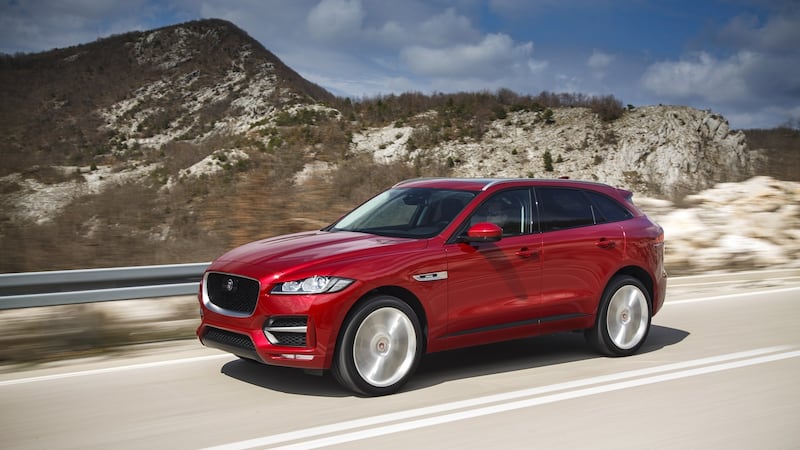Collecting my test car at a Dublin dealership I came across a Celtic Tiger sight: a queue. At lunchtime on a Monday.
One couple returned from a test, a smiling salesman in the back seat, while another waited patiently for their turn. Inside the showroom a salesman was breaking the news about delivery times to an eager buyer, citing demand in Asia and explaining the factory is working at full tilt.
The focal point for this extraordinary attention is Jaguar's new F-Pace crossover. It's been far too long, but finally Jaguar has a crossover for its forecourt. It's perhaps the ultimate symbol that the well-heeled middle classes migrate from regular saloons. After all, Jaguar is joined at the hip with its sister brand Land Rover, whose raison d'être is to service this market. Surely that should suffice? Apparently not. These days every brand needs a high-set offering. Suggestions are that Jaguar isn't going to stop here, with a larger SUV in the pipeline as well.


So what of the F Pace? Well, it's smartly styled with the big grille up front that's de rigeur on these crossovers. It's sleeker than its rivals, and in that way a little less boxy in the rear than the BMW X3, Mercedes-Benz GLC or the Audi Q5. It's also a little more subtle than the Lexus NX, more modern than the current Volvo XC60. It might lose out on looks to the Porsche Macan, but those are like hen's teeth at the moment so that won't really limit demand.
Inside it’s on a similar scale to rivals, with plenty of practical family space, with impressive legroom in the rear for adults, ample headroom as well, and a 650-litre boot, which is more than most of its rivals. It’s actually on a par with the likes of larger BMW X5 in this regard.
Lightweight
Up front the seats are firm, though not as comfortable or premium as the Mercedes, for example, while much of the switchgear is common to the recently launched XE saloon. While the auto comes with the trademark dial that rises when you start the car, the rest is a little lacking in effect. Even when you opt for the larger 10-inch touchscreen, it doesn’t have the same quality interface as those of the Mercedes or the ageing Audi.
Where it does excel is in engineering terms, and this where Jaguar mixes its own fondness for lightweight aluminium with some of the expertise and DNA of its Land Rover sister brand. The end result is a crossover that’s surprisingly agile. Still, the ride tends towards firm rather than comfort and on badly surfaced roads or a dirt track I would have expected a little more cushioning. The benefit of this stiffer ride is less body roll in bends and the F-Pace does handle more than a regular saloon when pushed through corners, though I would have liked a little more bite from the brakes.
One real positive of the F-Pace is the steering feel, which is remarkably smooth and precise for a car of this size. I noted the turning circle wasn’t fantastic in tight car park spots, but overall this Jaguar deserves a lot of kudos for its underpinnings. Our test car came with the firm’s all- wheel-drive system but it will be offered in two-wheel drive.
Up front our test car was powered by Jaguar’s new 2-litre 180bhp diesel. It packs a decent punch with 430Nm of torque and the stats show it’s as quick off the starting blocks as equivalent rivals. Yet you do need to engage sport in the transmission; in regular Drive mode the initial throttle response is rather flaccid and the car seems a little sluggish pulling away. That’s probably down to engineers leaning towards fuel economy. And the F-Pace delivers very credible figures, with an official combined fuel economy of 5.3 l/100km (53.3 mpg).
Dynamics
In terms of rivals, the Jaguar F-Pace can certainly hold its own. An price of €44,100 for the two-wheel drive SE will tempt many potential buyers to the forecourts. However, move up a specification level - to Prestige - and the price rises sharply to €49,310. Opt for a four-wheel-drive version and prices there start at €47,800 for manual transmission and €50,910 for automatic.
Those mid-specification prices aren’t out of line with rivals, though they are at the upper end of an increasingly crowded premium crossover market.
Still, I expect it will lure a lot of Irish motorists away from German brands. With F-Pace Jaguar has struck gold.
The lowdown: Jaguar F-Pace
Engine: 1999cc turbodiesel putting out 180bhp @ 4,000rpm and 430Nm of torque from 1,750rpm with manual or eight-speed auto transmission. Comes in all-wheel or rear-wheel drive
0-100km/h: 8.7 seconds
Fuel economy: 5.3 l/100km (53.3mpg)
Price: starting at €44,100 for rear-wheel drive SE; starting at €47,800 for four-wheel drive manual and €50,910 for four-wheel drive auto

